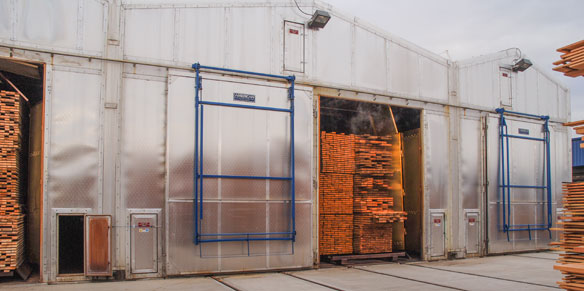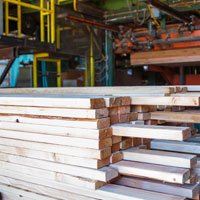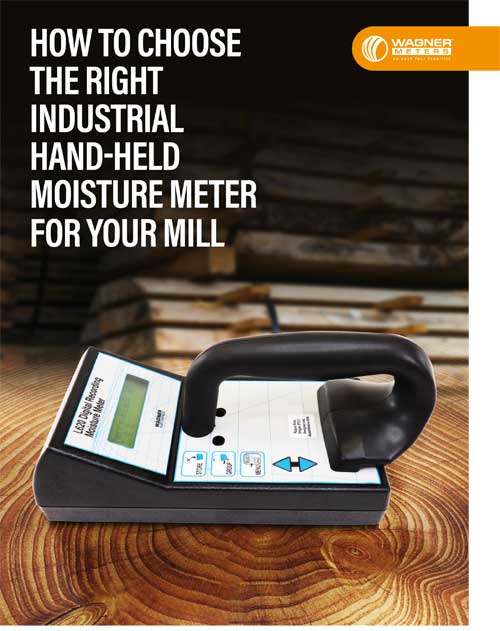When Kiln Drying Doesn’t Work

Written by Wagner Meters, published first by Floor Trends (November 2014 issue)
When looking at any type of unfinished wood at a lumberyard or flooring supplier, the majority of wood on the market has been kiln-dried to bring the wood’s moisture content (MC) into a workable range to prevent problems during the life of the final product.
Kiln drying is a controlled process that speeds the natural transition of moisture from “green” lumber to a wood product that will be free from warping, buckling, splitting and a host of other moisture-related defects.
However, it’s important to understand that kiln drying does not guarantee that moisture-related problems will never affect a particular piece of wood flooring. Kiln drying is only one step in the journey of any wood from its growing green life as a tree to its final finished wood product.
What Does Kiln Drying Wood Really Do?
A living tree is a series of interconnected cells and pathways that conduct water from the ground up through its trunk and branches to the tips of its leaves. When the tree is fresh cut, this moisture within the structure of the tree remains.
It will eventually leave the tree through evaporation, but this process (referred to as air drying, because it involves MC being carried away by ambient air currents) is a slow one. If a tree air-dries too quickly the wood can split, warp or crack, damaging the potentially useful wood.
Kiln drying uses a combination of heat and airflow to reduce the MC of green lumber in a shorter time frame than air drying would require. The target MC level will vary by wood species, but the ultimate goal is to have the wood reach a point that is roughly in balance with the relative humidity of the air around it.
Accordingly, each charge (or kiln load) is sorted by species and dimensions to optimize the process, to ensure that the final MC levels are even across the charge, and to bring the wood to an MC level compatible with a general guideline for wood MC.
In-line and in-kiln moisture measurement systems help to determine when the wood has reached optimal MC levels.
 Mills and manufacturers alike invest time, money and training into their drying processes to provide uniform results and optimal wood flooring products at the correct moisture levels for their customers. The kiln drying process provides the best possible environment for removing excess moisture from wood in a timely fashion, delivering the highest possible quality material. The goal is to remove the excess moisture while minimizing the damage to the wood that rapid changes might cause.
Mills and manufacturers alike invest time, money and training into their drying processes to provide uniform results and optimal wood flooring products at the correct moisture levels for their customers. The kiln drying process provides the best possible environment for removing excess moisture from wood in a timely fashion, delivering the highest possible quality material. The goal is to remove the excess moisture while minimizing the damage to the wood that rapid changes might cause.
So if the wood leaves the kiln at the required MC level, the MC process is complete, right?
Unfortunately, the answer is no.
What Kiln Drying Doesn’t Do
Wood is a hygroscopic material. It constantly interacts with moisture in its environment. The cells and pathways of the living tree will still absorb or release moisture as necessary to find a balance with its environment.
If the surrounding air is higher in MC(relative humidity), wood will absorb some of that moisture. If the air has lower moisture levels, the wood will release moisture. This process will continue back and forth until the wood has reached a point of balance with the surrounding air, a point called EMC, or equilibrium moisture content.
Why is that so important?
Wood may have the majority of its moisture removed during the kiln drying process, but it does not lose the ability to reabsorb moisture from its environment. Whether from a direct water source, moisture in an adjacent material or even humidity in the air, by its very nature, wood will be ready to absorb any moisture it contacts. Kiln drying doesn’t “fix” the MC level of a wood product; it merely reduces the amount of moisture to a generally workable range.
Wood’s MC will always be a variable, not a constant.
Here’s why kiln drying is only a first step in the MC process: At any step of the process after the kiln–transportation, manufacturing, storage or installation–it is possible for wood, even manufactured wood flooring, to lose additional moisture (in a dry environment) or re-absorb ambient moisture (in a humid environment) and have its MC level, and possibly even its dimensions, change again. This can present some very real challenges for you as the end user, particularly if you assume that kiln-drying alone is sufficient to protect from moisture-related problems.
Moisture Measurement in Wood Flooring
Wood flooring installers know wood’s MC varies depending on its environment. It’s just as important to allow each board bundle to acclimate to the job site environment before installation begins as it is for the manufacturer to make sure the MC is accurately monitored before it leaves the plant. Any flooring must be allowed time to adjust to the job site before beginning assembly, sanding or staining.
Whatever your application, the wood you use must be given time to adjust to the environment in which it will be worked or installed.
How to Accurately Monitor Wood’s MC
 A simple and easy-to-use wood moisture meter can provide quick, accurate and reliable monitoring of wood flooring to ensure that the installed floor will not suffer from moisture-related problems. Pinless wood moisture meters, like our non-damaging line of wood moisture meters, can be used as often as necessary without marking the floor boards or causing imperfections that will become visible once the finish is applied.
A simple and easy-to-use wood moisture meter can provide quick, accurate and reliable monitoring of wood flooring to ensure that the installed floor will not suffer from moisture-related problems. Pinless wood moisture meters, like our non-damaging line of wood moisture meters, can be used as often as necessary without marking the floor boards or causing imperfections that will become visible once the finish is applied.
At Wagner Meters, we know an accurate wood moisture meter can keep you informed during each step of your process and ensure your success every step of the way. Our wood moisture meters are designed to help wood flooring installers be sure their wood is ready for the project at hand.
From the first stages at the kiln to the first steps of each wood flooring project, the first order of business is to measure and be sure that the wood has acclimated to the right MC levels before beginning the job. Kiln drying is only the first link in the chain of MC management that is necessary for durable and beautiful finished wood projects.

Free Download – How to Choose the Right Industrial Hand-held Moisture Meter for Your Mill
Tony Morgan is a senior technician for Wagner Meters, where he serves on a team for product testing, development, and also customer service and training for moisture measurement products. Along with 19 years field experience for a number of electronics companies, Tony holds a B.A. in Management and his AAS in Electronics Technology.
Related Posts via Taxonomies
Last updated on June 8th, 2021




We are putting down Kentwood Acaia wood. It been in our home for 2 months. Humidity level 11.4. The installer comes by every 10 days. The last week we have been running 2 dehumidifier to help. Today he stopped by it’s still at 9:4. We can’t seem to get it lower. We turned off the humidifier in the house. Live in Chicago. Getting frustrated. What should we do?
I have an issue with large dimension wood 9’ x 8” coming out of a kiln dried that has large cracks and is warped. How can this be solved
Cracking can be caused by different things such as too much heat applied too fast, airflow issues in the kiln, drying temperatures too high. Warping can be caused by drying too slow, or not using top weights.
Kiln drying wood has so many factors that need to be taken into account; wood species, heat type, temperatures, dimension, kiln size, kiln type, seasonal weather changes, even the time of year when the lumber was cut, are but a few of these factors. There are just too many variables to be able to answer your question effectively.
I suggest going to the Forest Products Laboratory at: Forest Products Laboratory-Kiln Drying articles, and researching the kiln drying literature they list for more comprehensive information on kiln drying problems and solutions.
Another possibility is taking a lumber drying workshop or kiln drying course. These are offered as classes, or on-line, and also give you the opportunity to work with other kiln operators to get real world answers to your questions. Oregon State University is one of the many organizations that offer lumber drying workshops: OSU-Lumber Drying Online Workshop.
Would you use a moisture meter for wood that has been dead in log form for many years then sat out drying in 99+ degree weather after being milled for several months? Or is it just necessary when dealing with kiln-dried wood?
Just because the tree is dead, and has been milled, is no reason to assume it is dry. It may be, but making that assumption could ruin whatever project the wood is slated for. This is especially true for hardwood, exotic woods and even kiln dried wood. The best way to ensure the wood is dry and ready for a project is to test it using a quality moisture meter. The Wagner MMC line of moisture meters is a great choice for this type of application. Please check and see which meter would best suit your needs:
https://www.wagnermeters.com/moisture-meters/comparison-matrix/